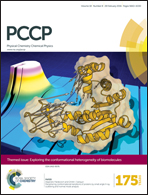Structural transition upon hydrogenation of B20 at different charge states: from tubular to disk-like, and to cage-like†
Abstract
Extensive first-principles theoretical investigations indicate that neutral B20 undergoes a dramatic structural transition upon partial hydrogenation, from the tubular D2d B20 (1), to the disk-like C2v B20H2 (4), and then to the cage-like C2 B20H4 (7). Both the singly charged C2v B20− (2) and C2 B20H2− (5) favor 2D disk-like planar structures with a filled hexagon (B7) at the center, while C2 B20H4− (8) follows its neutral counterpart with a 3D cage-like geometry. All the doubly charged C2v B202− (3), C2 B20H22− (6), and C1 B20H42− (9) turn out to prefer planar or quasi-planar 2D structures over 3D geometries, with the most stable B20H42− (9) possessing a unique hexagon hole (B6) at the center. Detailed CMO and AdNDP analyses reveal that both the perfect planar B202− (3) and B20H2 (4) possess concentric dual π aromaticity, with two π-electrons delocalized over the filled hexagon B7 at the center and ten π-electrons delocalized between the filled B7 and the B13 outer ring, each separately conforming to 4n + 2 Hückel's rule. They are therefore the boron analogues of coronene (D6h C24H12). The quasi-planar C2 B20H22− (6) and C1 B20H42− (9) also appear to be π aromatic with one π system following the 4n + 2 rule. The B20H42− (9) structure with a hexagon hole may serve as the embryo for monolayer boron α sheet. Both the cage-like C2 B20H4 (7) and C2 B20H4− (8) appear to be 3D aromatic with the large negative NICS values of −51.5 and −55.5 ppm, respectively. The structural changes from 1 to 9 reflect a competition between 2D and 3D aromaticities in these clusters, depending on the extent of hydrogenation and electronic charge states. The PES spectra of B20H2− (5) and B20H4− (8) are predicted to facilitate their future experimental characterizations and production.


 Please wait while we load your content...
Please wait while we load your content...